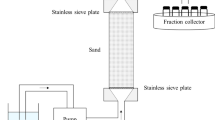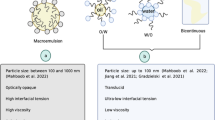Abstract
The objective of this study was to investigate the correlation between oily soil removal efficiency and low oil-water interfacial tension (IFT) generated by microemulsion formation. A mixture of sodium dioctyl sulfosuccinate, alkyl diphenyl oxide disulfonate, and sorbitan monooleate was selected as a detergent formulation to evaluate detergency performance for two highly hydrophobic oils: hexadecane and motor oil. The maximum detergency corresponds to formation of a Winsor Type III microemulsion as well as to the supersolubilization region, which is a Winsor Type I microemulsion close to the Winsor Type III region. In addition, the oil removal in the rinse step is almost as high as that in the wash step for both regions. We propose the following mechanism to explain these results: During the wash step, the contact angle of the oil on the fabric surface is progressively increased, resulting in the detachment of the oil droplets. However, owing to the very low IFT, the spreading effect is dominant, thereby causing incomplete oil removal. During the subsequent rinse step, the IFT increases, passing through a composition at which the rollup mechanism causes additional oil removal. These results demonstrate that microemulsion formation and the resulting IFT reduction are important mechanisms in oily soil detergency.
Similar content being viewed by others
Abbreviations
- ADPODS:
-
alkyl diphenyl oxide disulfonate
- AOT:
-
dioctyl sodium sulfosuccinate
- CP:
-
commercial liquid detergent product
- DI:
-
defonized
- HLB:
-
hydrophile-lipophile balance
- IFT:
-
interfacial tension
- O/W:
-
oil-in-water
- PIT:
-
phase inversion temperature
- Span 80:
-
sorbitan monooleate
- SPS:
-
supersolubilization
- W/O:
-
water-in-oil
References
Wu, B., J.H. Harwell, D.A. Sabatini, and J.D. Bailey, Alcohol-Free Diphenyl Oxide Disulfonate Middle-Phase Microemulsion System, J. Surfact. Deterg. 3:465 (2000).
Pope, G.A., and W.H. Wade, Lessons from Enhanced Oil Recovery Research for Surfactant-Enhanced for Surfactant-Enhanced Aquifer Remediation, in Surfactant-Enhanced Subsurface Remediation: Emerging Technology, edited by D.A. Sabatini, R.C. Knox, and J.H. Harwell, ACS Symposium Series, Washington, DC, 1995, Vol. 594, p. 142.
Nagarajan, R., and E. Ruckenstein, Molecular Theory of Microemulsions, Langmuir 16:6400 (2000).
Dillan, K.W., E.D. Goddard, and D.A. McKenzie, Oily Soil Removal from a Polyester Substrate by Aqueous Nonionic Surfactant Systems, J. Am. Oil Chem. Soc. 56:59 (1979).
Dillan, K.W., E.D. Goddard, and D.A. McKenzie, Examination of the Parameters Governing Oily Soil Removal from Synthetic Substrate, J. Am. Oil Chem. Soc. 57:230 (1980).
Solans, C., J.G. Dominguez, and S.E. Friberg, Evaluation of Textile Detergency of Microemulsions in Systems of Water Nonionic Surfactant and Hydrocarbon at Low Temperature, J. Dispersion Sci. 6:523 (1985).
Solans, C., and N. Azemar, Detergency and HLB Temperature, in Organized Solutions, edited by S.E. Friberg and B. Lindman, Marcel Dekker, New York, 1992, p. 273.
Mori, F., J.C. Lim, O.G. Raney, C.M. Elsik, and C.A. Miller, Phase Behavior, Dynamic Contacting and Detergency in System Containing Triolein and Nonionic Surfactants, Colloids Surf. A 40:323 (1989).
Azemar, N., The Role of Microemulsions in Detergency Processes, in Industrial Applications of Microemulsions, edited by C. Solans and H. Kunieda, Marcel Dekker, New York, 1997, p. 375.
Thompson, L., The role of Oil Detachment Mechanism in Determining Optimum Detergency Conditions, J. Colloid Interface Sci. 163:61 (1994).
Azemar, N., I. Carrera, and C. Solans, Studies on Textile Detergency at Low Temperature, J. Dispersion Sci. Technol. 14:645 (1993).
Goel, S.K., Phase Behavior and Detergency Study of Lauryl Alcohol Ethoxylates with High Ethylene Oxide Content J. Surfact. Deterg. 3:221 (2000).
von Rybinski, W., Surface Chemistry in Detergency, in Handbook of Applied Surface and Colloid Chemistry, edited by K. Holmberg, D.O. Shah, and J.S. Milan, John Wiley & Sons, West Sussex, United Kingdom, 2002.
Tongcumpou, C., E.J. Acosta, L.B. Quencer, A.F. Joseph, J.F. Scamehorn, D.A. Sabatini, S. Chavadej, and N. Yanumet, Microemulsion Formation and Detergency with Oily Soils: II. Detergency Formulation and Performance, J. Surfact. Deterg. 6:205 (2003).
Broze, G., Detergents and Cleaners, in A Handbook for Formulators, edited by K.R. Lange, Hanser, Munich, Germany, 1994, p. 29.
Miller, C.A., and K.H. Raney, Solubilization Emulsification—Mechanisms of Detergency, Colloids Surf. A 74:169 (1993).
Bourrel, M., and R.S. Schechter, Microemulsions and Related Systems, Marcel Dekker, New York, 1998, pp. 22, 169.
Tongcumpou, C., E.J. Acosta, L.B. Quencer, A.F. Joseph, J.F. Scamehorn, D.A. Sabatini, S. Chavadej, and N. Yanumet, Microemulsion Formation and Detergency with Oily Soils: I Phase Behavior and Interfacial Tension, J. Surfact. Deterg. 6:191 (2003).
Goel, S.K., Measuring Detergency of Oily Soils in the Vicinity of Phase Inversion Temperatures of Commercial Nonionic Surfactant Using an Oil-Soluble Dye, J. Surfact. Deterg. 1:221 (1998).
Raney, K.H., and H. Benson, The Effect of Polar Soil Compounds on the Phase Inversion Temperature and Optimum Detergency Conditions, J. Am. Oil Chem. Soc. 67:722 (1990).
Raney, K.H., Optimization of Nonionic/Anionic Surfactant Blends for Enhanced Oily Soil Removal, J. Am. Oil Chem. Soc. 68:522 (1991).
Reed, R.L., and R.N. Healy, Contact Angles for Equilibrated Microemulsion Systems, Soc. Petrol. Eng. J. 24:342 (1984).
Author information
Authors and Affiliations
Corresponding author
About this article
Cite this article
Tongcumpou, C., Acosta, E.J., Quencer, L.B. et al. Microemulsion formation and detergency with oily soils: III. Performance and mechanisms. J Surfact Deterg 8, 147–156 (2005). https://doi.org/10.1007/s11743-005-340-8
Received:
Accepted:
Issue Date:
DOI: https://doi.org/10.1007/s11743-005-340-8




